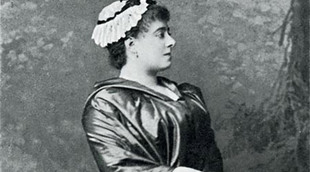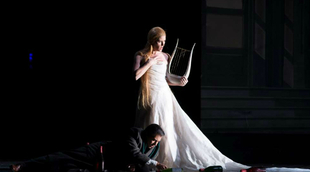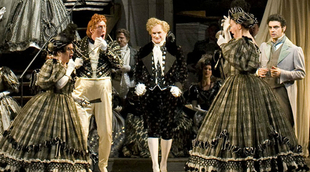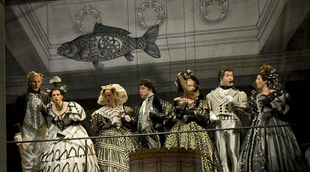 © DR
© DR
Long considered an amusing “operetta maker”, Jacques Offenbach, the symbol of Parisian gaité under the Second Empire, left his Contes d’Hoffmann to posterity just before dying (he never saw the premiere). A darkly fantastical work on the search for the absolute and the feminine ideal, which became a masterpiece of French romanticism, proving to be resolutely modern in its construction.
In a few days we’ll be able to hear The Tales of Hoffmann first at the Paris Opera beginning on 3 November, with Ramon Vargas in the title role (replacing Jonas Kaufmann who had originally been announced) alongside Stéphanie d'Oustrac and Ermonela Jaho, and then at the London Royal Opera House starting on 7 November 7 with Vittorio Grigolo and Sonya Yoncheva. Two opportunities to delve into the meaning and issues raised by Jacques Offenbach’s “swan song”.
***
When Jacques Offenbach died on 5 October, 1880, the score for The Tales of Hoffmann was not yet finished, even though the work had already been in rehearsal at the Opéra-Comique since 11 September. Auguste Offenbach asked Ernest Guiraud to complete score left by his father. Five years earlier, this same Guiraud had already completed Bizet’s Carmen. Offenbach fought his illness to the bitter end so that he could complete his project. He wanted to die as an opera composer, not a frivolous musician, a champion of bourgeois pleasures under the Second Empire. He knew he absolutely must finish The Tales of Hoffmann, which he had been dreaming of and working on for years, hoping to achieve the official consecration that would ensure him of triumphing at the Opéra-Comique, the respectable theatre of bourgeois marriages. Aware that he had little time left, Offenbach sent a letter to the director of the prestigious establishment; it ended with this plea: “Stage my opera quickly, I am in a hurry, a hurry!”. Does The Tales of Hoffmann occupy only a marginal place in Offenbach’s production? With this fantasy opera, so unexpected of the author of Orphée aux Enfers (1858) and La Belle Hélène (1864), a Pandorra’s Box of passionate interpretations and studies was opened, so that a definitive version of the score could be established at last.
“Like the divine Mozart”
It is reported that, upon hearing of Offenbach’s death, Richard Wagner exclaimed: “He knew how to go about it, like the divine Mozart.” What finerhomage could one bestow upon this incomparable musician? He was as brilliant with parody and biting irony as with the most desperate melancholy and bitterness. Far from being content with being a wonderful maker of operettas, the man whom Rossini dubbed the “little Mozart of the Champs-Elysées” aspired to other things. This ambition seems to be part of the very construction of The Tales of Hoffmann. The work opens and closes with the “opera of operas”, the absolute reference point, Mozart’s Don Giovanni. Indeed, the Prologue takes us into the tavern of Master Luther whilst, in the theatre next door a performance of Don Giovanni is going on, with Stella, whom Hoffmann considers the ideal woman, playing the role of Donna Anna. Rather than attending the second act of Don Giovanni that is just starting, a raucous group of students prefer to continue drinking and listening to Hoffmann, whose three tales use the cinematographic flashback technique.

Marie Heilbron
The performance of Mozart’s opera ends just at the moment when the poet, now completely drunk, finishes the telling of his “mad love affairs”. And when Stella appears to accept ovations and homages, Hoffmann, no longer able to speak to her, lets her leave on the arm of his rival, Lindorf. The opera thus includes three different registers, like a set of Russian dolls. In the noisy, smoky tavern, supposedly representing the “real”, Hoffmann is begged by the assembly to talk about his strange life. In the background, and simultaneously, the performance of Don Giovanni is proceeding, as if Offenbach had wanted to situate his work in the wake of the absolute reference in matters operatic. Finally, on stage, between drunkenness and dreams of the past, the three tales devoted to the three women the poet loved form the work’s essential plot. We will be introduced to Olympia, the “lifeless doll with a heart of ice”, Antonia, “the virtuosa”, and Giulietta, “the courtesan with the bronze complexion”… “A charming trio of enchantresses who shared “the poet’s days, surpassing the mere mistresses of the students at the tavern. But these three women blend into one, the incomparable singer Stella: “Artist, girl and courtesan!”. Initially Offenbach had assigned the four female roles to a single performer, Belgian coloratura Marie Heilbronn, the future original Manon in Massenet’s opera (1884). We are already dealing with a game of mirrors, in the drama and in execution of the score. The Hoffmann character will end up losing his reflection in it, becoming the plaything of infernal powers embodied by Dapertutto.

Les Contes d'Hoffmann - Opéra de Paris - 2012/2013
What continuity can we find between The Tales of Hoffmann and the effervescent refrains of La Vie parisienne (1866)? A good loser, the composer and critic Ernest Reyer acknowledged: “I doubt, as I wrote somewhere many years ago, that a serious work can ever come from the pen that wrote the eccentricities of Orphée aux Enfers’ and ‘La Belle Hélène’. Well, now! I was mistaken.” The famous “Kleinzach’s Song” (Act I) is an enlightening example, showing that there is no break or renunciation in Offenbach’s inspiration but, on the contrary, continuity and fulfilment. This popular song evokes a small, grotesque being, like a gnome, taken straight out of medieval imagery. The aria, written in the form of couplets, begins with a lively, swirling rhythm. Intended to amuse the assembly, which takes up the chorus with its grotesque refrain, the song suddenly changes tone when Hoffmann’s mind strays off course: Kleinzach’s ridiculous face is replaced by the charming visage of his beloved. The musical climate changes completely, guided by the melancholy nature of the memory. The song’s syncopated rhythm is then replaced by long, sinuous and enveloping musical phrases, like the smitten poet’s dream, lost in a world without beauty, for whom laughter and farce are the only values that count. Before his astonished listeners, Hoffmann celebrates the “vibrant and sweet” voice of the woman who “cast this winning song Whose eternal echo resonates in (his) heart!”. Is this not a summary and mise en abyme of the composer’s own situation? Offenbach was an entertainer. “Let us enjoy the good days, they will not last”, he writes in his La Belle Hélène… He was able to use his talents in service of the smallest operetta, Monsieur Choufleuri restera chez lui (1861), and yet compose one of the most beautiful romantic operas of his time. The same rich harmony, the same melodic sense, the same science of orchestration as in his many pieces of chamber music and his grand symphonic tableaux. Referring to the trio between Hoffmann, Crespel and Doctor Miracle in Antonia’s Act, writer-journalist Auguste Vitu acknowledged in astonishment: “To write this powerful page, Jacques Offenbach found deeply energetic accents of which we were not supposed to suspect him capable.” Yet the long and difficult genesis of The Tales of Hoffmann can help us recognize the many bonds that link it to the composer’s life, like the works that preceded and paved the way for it.
In 1864, Les Fées du Rhin, commissioned by the Imperial Opera, premiered in Vienna.The Viennese did not have the same prejudices as the Parisians, and Offenbach was able to develop the fantastical dimension of this “serious” score, which revealed another aspect of his inspiration. It is not unreasonable to think that, with his Tales, Offenbach followed his own evolution without necessarily seeking to adapt to the new moral climate that took over with the advent of the Third Republic. The overture to Les Fées du Rhin had as its theme a “chorus of Rhine spirits”, which we also encounter in The Tales of Hoffmann: this is the famous barcarolle sung by Nicklausse and Giulietta, “Belle nuit, ô nuit d’amour”.
Triumph at the Opéra-Comique

Les Contes d'Hoffmann - ROH
When Offenbach held the position of conductor at the Comédie-Française, a fantasy drama by Jules Barbier and Michel Carré, who were to become the librettists for Gounod’s Faust (1859), among other things, was presented at the Odéon on 21 March, 1851. The Tales of Hoffmann was freely adapted from three short stories by Ernst Theodore Amadeus Hoffmann (1776-1822): L’Homme au sable (1816) for the character of Olympia, Le Conseiller Krespel (1818) for that of Antonia and Les Aventures de la nuit de la Saint-Sylvestre (1815) for that of Giulietta. Years later, the tales imagined by Hoffmann fascinated Freud who analysed the world of L’Homme au sable in order to develop this theories on “disturbing strangeness”.
During the period from 1830 to 1840, Hoffmann was the most popular German romantic author among the French. He had a profound influence on an entire generation of authors: Honoré de Balzac, Charles Baudelaire, George Sand and Alexandre Dumas owe him a debt. In 1836, Théophile Gautier noted, not without irony: “His tales have been read by everyone; the charwoman and the grand lady, the artist and the grocer were all thrilled with them”. His success was such that it offended Scottish novelist Walter Scott, the most widely read novelist in France at the time. Seeing him as a potential rival, Walter Scott helped give Hoffmann the image of a neurotic author seeking inspiration in alcohol… Nothing would ever overcome this image of a bohemian artist, exalted lover and unhappy man who drowns his pain in wine, the main driver of his inspiration. In his Psychanalyse du feu (1938), Gaston Bachelard (1884-1962) refers to the “Hoffmann complex” that led the writer to free his imagination through punch, madness and drunkenness. Present throughout Offenbach’s work, drinking choruses take on singular importance in The Tales of Hoffmann: they open and close the evocation of past loves on the border between dream and reality.

Les Contes d'Hoffmann - ROH
Jules Barbier and Michel Carré built their play by blending real elements from Hoffmann’s life with elements from his fantasy short stories. Jules Barbier came up with the idea of making the poet both the narrator and the protagonist of the drama. In his search for the ideal woman, the unhappy hero comes up against a diabolical character who manipulates the women he loves. It is assumed that Offenbach saw this play, which already included a musical part, but it was not until 1873 that he actually dreamed of making it into an opera. Michel Carré had died the year before, and it was Jules Barbier who adapted the play for the opera stage. In 1866 the first adaptation had been done by Hector Salomon (1838-1906), but the premiere of his opera had been postponed.
After two years of work, Barbier presented his project to Offenbach. The two men developed a long correspondence, having known and admired each other for a long period of time. During the six years that separated the first outlines of the opera’s posthumous premiere on 10 February 1881, obstacles accumulated: successive bankruptcies of the theatres approached, the librettist’s hesitations, Offenbach’s illness, premieres of a dozen other works, not to mention a tour of the United States during which Offenbach still found time to compose, La Boîte à lait, an opera buffa… Out of all these events, only one date is worth remembering: 18 May 1879. Offenbach held an introductory concert at his home, attended by Léon Carvalho, the powerful director of the Opéra-Comique where the composer had until then experienced only failures! Considered a vulgar operetta maker, he had seen his Fantasio (1872), based on a play by Musset, received disparagingly. This work foreshadowed the poetry of The Tales of Hoffmann , which was to become the musician’s revenge: the premiere, which did take place at the Opéra-Comique, was a true success, attended by le Tout Paris who came to hear the astonishing “swan song” of the man who was the very symbol of la gaité parisienne.
Hoffmann’s dreamed-of life, or Offenbach’s?
Jacques Offenbach
The libretto and score of The Tales of Hoffmann may serve as an illustration of Jacques Offenbach’s life. There was his childhood, when the curtain opened on the tavern of Master Luther, “At the Keg in Nuremberg” that served as the setting for the opera’s Prologue and Epilogue. When he was 11, Offenbach formed a trio with his brother and sister, performing in the taverns of Cologne, his birthplace.
In 1833, when the 14-year-old German musician arrived in Paris, he understood at once that he needed to build himself a “character” in order to win over the dazzling capital. Offenbach made his entry into the salons of the July Monarchy. “With his long hair, unassuming size and inspired forehead, he might be taken for a character from the ‘Contes Fantastiques’”, wrote an observer in 1843. In his Dictionary of Received Ideas, Flaubert noted: “As soon as you hear his name, you have to close two fingers of your right hand to protect yourself from the evil eye.” To his romantic aspect, which made him a brother to Hoffmann, Offenbach also added a “diabolical” dimension that allies him to Lindorf, Coppélius, Miracle amd Dappertuto, the various guises the devil takes on in The Tales of Hoffmann. The four roles are written to be assigned to the same baritone.
Wasn’t it inevitable that Offenbach would be drawn to E.T.A. Hoffmann ? Let us not forget that the writer was also passionate about music. He composed several operas, particularly Ondine (1816). His musical fervour led him to change his third given name to “Amadeus”, an homage to Mozart. An astonishing game of mirrors occurs between the writer and composer E.T.A Hoffmann, his characters and Offenbach, the future composer of The Tales of Hoffmann. The musician enjoys developing the theme of the opposition between art and life. Renouncing the impossible idea of fulfilment through love, his character Hoffmann must prefer to follow his Muse, in the form of Nicklausse, a “schoolboy”, sung by a woman in drag. As both guide and conscience, Nicklausse, throughout the opera, will clarify the meaning of what he is experiencing until the final reassurance: “Que la tempête Des passions s’apaise en toi! L’homme n’est plus, renais poète!”
It is hopeless to try to define a work that is much like a kaleidoscope, blending the real and the imaginary, literature and music, love and artistic creation. What Arianna’s thread can we follow to account for all these detours? The game of mirrors expands: a single soprano to embody four women, a single baritone to belt out the sniggering of four characters, a single tenor to play four puppets worthy of an operetta: Andrès, Cochenille, Frantz and Pitichinaccio… And as many versions as productions, each favouring different editions, whether that of Choudens, chosen until 1970, or those of Fritz Oeser or Michael Kaye who is favoured today. A sombre, complex and powerful work, The Tales of Hoffmann avoids all the clichés attached to the man who, in the Second Empire, established himself as the unchallenged emperor of opera buffa.
the 27 of October, 2016 | Print



Comments